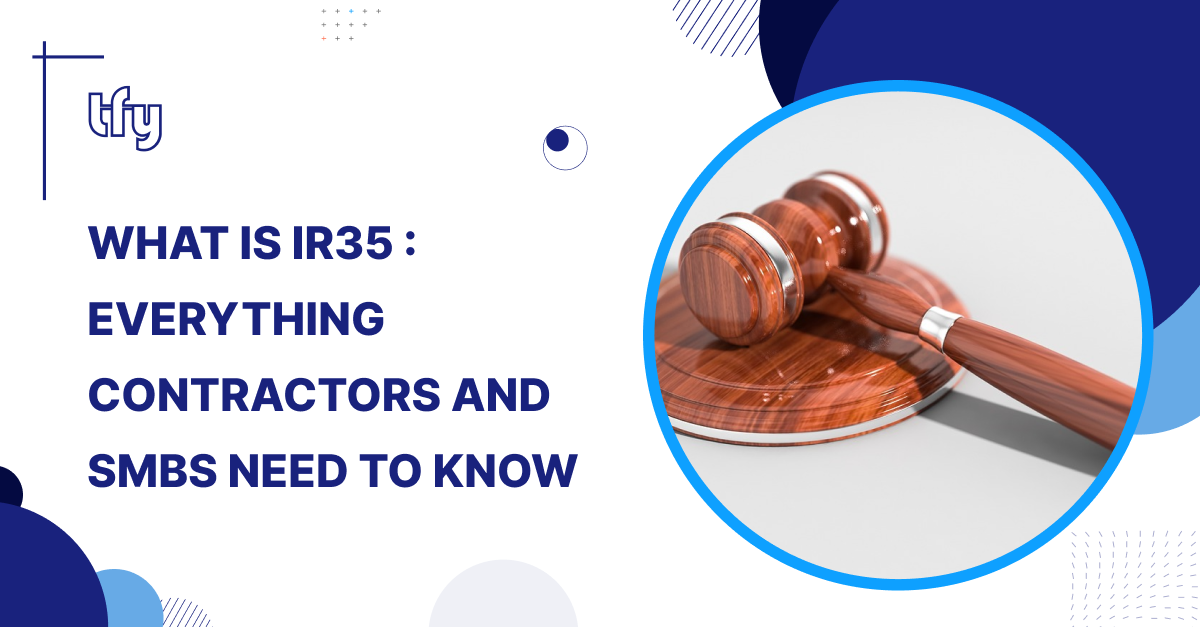
The world of contractor employment and freelancing is complicated, with numerous variables that add to its difficulties. One of these elements is IR35, a package of tax laws that greatly influences how small-to-medium businesses (SMBs) and contractors conduct their business. That's why we have created this article to give readers a thorough grasp of IR35, its consequences, and how to deal with its intricacies.
What is IR35?
IR35, or the off-payroll working regulations, is a policy that His Majesty's Revenue and Customs (HMRC) implemented in the United Kingdom. It was first established by the UK government in 2000. This tax law seeks to guarantee that, while working under comparable conditions to workers, contractors who provide services through an intermediary—such as a limited company—pay roughly the same taxes and national insurance payments as employees.
The introduction of the act was prompted by allegations of tax evasion by contractors who were, in essence, employees of the company they were providing their services to. These contractors could lower their national insurance and tax obligations by using intermediaries. So, the goal of IR35 is to minimise covert employment and guarantee equitable taxation.
Importance of IR35 for Contractors and SMBs
For both contractors and SMBs, understanding IR35 is essential. Contractors need to ensure they are paying the correct amount of tax and safeguarding their financial interests. While small and medium-sized businesses (SMBs) should be aware of their duties when managing and collaborating with contractors to protect themselves from liabilities.
Being subject to IR35 as a contractor might have serious financial repercussions. It may result in increased taxes and national insurance contributions, which could drastically lower their take-home pay. It may also affect how they run their company, reducing the advantages and flexibility of being a contractor.
For small and medium-sized businesses, being aware of IR35 can help them manage their interactions with contractors and reduce potential risks. They may be subject to severe financial fines and harm to their company's reputation if it is discovered that they have contractors disguised as employees.
Inside and Outside IR35 Meaning
The status of a contractor's relationship with their customer is indicated by the phrases "inside" and "outside" of IR35. If an independent contractor is 'Inside IR35', it means that they are treated as employees for income tax and national insurance reasons. On the other hand, being 'outside IR35' indicates that the contractor is truly self-employed and is not impacted by the same taxes and national insurance requirements.
Determining whether a contract is inside or outside of IR35 is a complex process that relies on many variables. Some of these most important elements include mutuality of obligation, control, and the right of substitution, among other things.
Determining if you are Inside or Outside IR35
Let's take a look at the factors by HMRC that determine the IR35 status:
Control and Supervision
The contractors' degree of control over where, when, and how they work is a major factor in figuring out their IR35 status. Requirements regarding work hours and places indicate that they are employed and fall inside IR35.
Right of Substitution
Another important consideration is whether the contractors have the authority to assign someone else to finish the task in their place. If they are unable to substitute someone else to do their work, it's likely that they fall inside IR35.
Investment and Financial Risk
The contractors' IR35 status is also influenced by the quantity of money they invest in their personal company and their degree of financial risk. They may be outside IR35 if they invest in tools or supplies to complete their project and take on a sizable amount of financial risk.
Mutuality of Obligation
The term "mutuality of obligation" (MOO) describes if the contractor and the client have a continuous expectation of work. A high MOO level may indicate employment and eligibility for inside IR35 benefits.
Length of Engagement
Long-term agreements with a single client could be a sign of employment, and such contractors should be put inside IR35. Similarly, working on short-term projects for different clients can indicate they're outside of IR35.
Advantages
Lastly, the contractors' IR35 status may also depend on the kind of benefits they receive. Should they obtain benefits akin to those provided to workers, including paid time off or sick pay, this may suggest that they fall inside IR35.
Note: To help determine a contractor's employment status for tax, they can use the Check Employment Status for Tax (CEST) tool provided by HMRC.
IR35 Tax Calculator
An IR35 tax calculator is a helpful tool for rapid assessments, but it shouldn't be your only guide through IR35 compliance. These calculators may omit important details of your particular working arrangement because they frequently use condensed factors and simplified algorithms. Think of them as convenient digital maps. They are helpful for gaining a rough sense of direction, but they are not trustworthy enough to navigate the complex backroads of IR35. Seek expert advice from IR35 specialists or certified accountants for a more precise and secure journey. After all, your financial well-being should merit a well-prepared journey rather than a problematic quick cut.
Note: You can also get help from this online IR35 tax calculator for better estimations.
IR35's Effects on Contractors
The consequences of being covered by IR35 as a contractor can be severe. First off, just like if they were an employee, they would have to pay income tax and national insurance contributions. This may result in a significant decrease in their take-home earnings. Additionally, they can lose some of the tax benefits of operating their own limited business, like the opportunity to write off specific costs.
Becoming an "inside IR35" contractor can also have an operational impact on their personal company. Some of the freedom that comes with being an independent contractor may be lost, like the option to decide where and when to work. It may also affect their feeling of autonomy and management over their entity, which is a major attraction for many contractors.
It's also crucial to remember that contracting doesn't always end with IR35. Contractors can continue to conduct business outside of IR35 by exercising cautious planning and management, as well as by making sure that their contracts and working procedures accurately reflect a business-to-business connection.
IR35's Effects on Small and Medium-Sized Businesses (SMBs)
Most SMBs are responsible for conducting status assessments and deducting taxes at source on behalf of their contractors. Plus, they may be subject to large financial obligations, such as back taxes, fines, and interest, if they're found to be employing disguised employees. As a result, it could significantly affect the company's financial stability.
Furthermore, IR35 may have an effect on their interactions with contractors. In order to make up for their higher tax liability, contractors who are subject to IR35 may choose to look for work elsewhere or ask for higher rates. This can result in a loss of essential personnel and higher labor expenses.
So, it's critical to check their contracts and contractor working procedures in order to safeguard the company. Maintaining good relations with the contractors and reducing potential liabilities are two benefits of ensuring the arrangements comply with IR35.
Strategies to Manage IR35 Compliance for Contractors and SMBs
Proactive management of IR35 compliance is necessary for good management. As a contractor, one must ensure that the agreements and methods of operation accurately represent a business-to-business exchange. This could entail avoiding mutuality of obligation, having the authority to send a substitute, and exhibiting control over the task.
Managing IR35 compliance for small and medium-sized businesses (SMBs) entails evaluating the contractor ties to make sure they truly represent a business-to-business relationship. This could entail altering how they interact with contractors, including giving them more freedom regarding where, when, and how they work. There may be fines and penalties for non-compliance. Still, there are services like Transformify's Vendor Management System that can assist with handling IR35 payment and compliance needs.
Also, seeking professional advice is crucial when handling IR35. Obtaining professional advice can help you successfully navigate the sometimes complex tax laws. Expert consultants can assist you in evaluating your agreements and operational procedures, spotting possible hazards, and creating risk-reduction plans.
Lastly, many materials are also at your disposal to assist you in comprehending and handling IR35. Online forums, trade associations, and government websites can all offer helpful advice and information. Keep yourself educated and current because laws and guidelines are subject to regular changes.
In conclusion - IR35's future
Despite the uncertainty surrounding IR35's future, one thing is certain: it does and will always have a big impact on SMBs and contractors. It is essential to comprehend and handle IR35 properly because it can significantly affect operations and finances.
Staying informed and getting professional guidance becomes even more crucial when laws change and the business environment shifts. You will preserve your financial interests, uphold your company's reputation, and confidently negotiate the complexity of IR35 by doing this.
In conclusion, even though IR35 may appear overwhelming, you can successfully manage its ramifications and operate as a contractor or SMB if you have the appropriate information and techniques.
Disclaimer: The information in this article does not constitute legal advice. Please seek legal advice if you need guidance regarding IR35.



